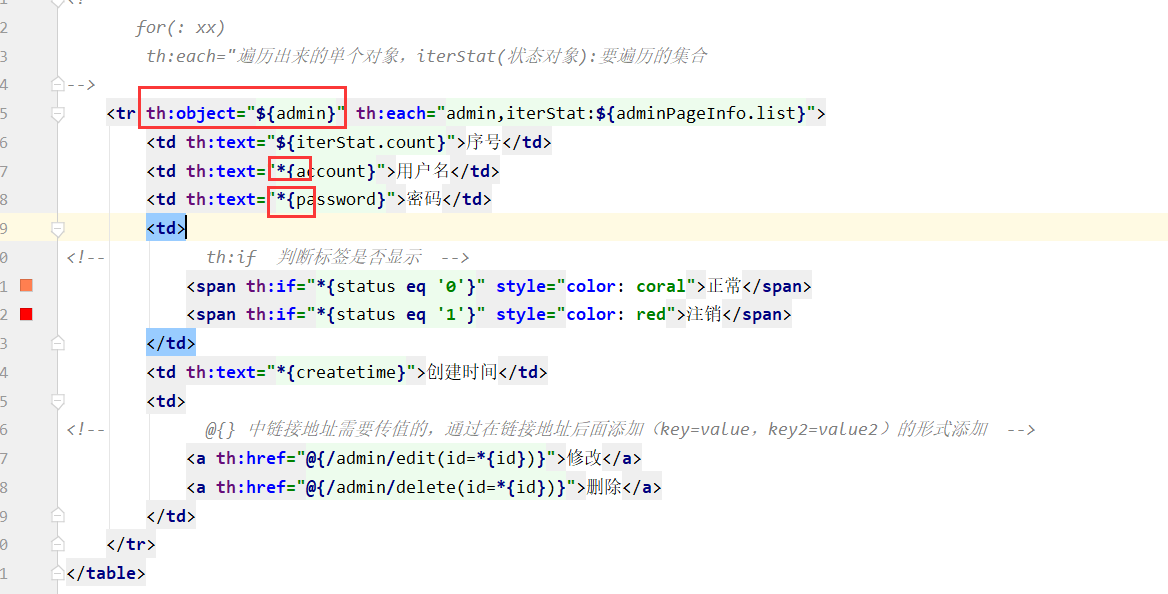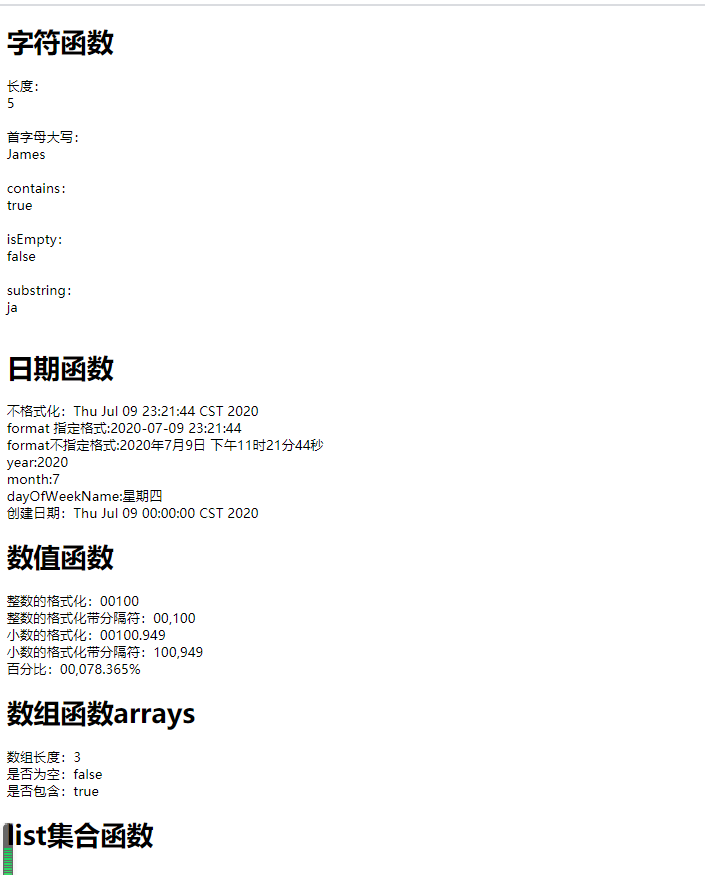一、Thymeleaf简介
Thymeleaf模板引擎主要用来做视图的展示。在springboot中默认支持thymeleaf,来替代原来ssm项目中的jsp。相较于jsp或其他的模板引擎,thymeleaf有如下特点:
1)动静结合,thymeleaf 既可以在有后台交互的情况下运行,也可以在不与后台交互的情况下运行,方便前后端开发人员协同开发;
2)多方言的支持,支持spring的标准方言,可以和springboot完美整合;
二、Thymeleaf 使用
1)在pom.xml文件中导入依赖;
<!-- thymeleaf 模板依赖-->
<dependency>
<groupId>org.springframework.boot</groupId>
<artifactId>spring-boot-starter-thymeleaf</artifactId>
</dependency>
2) 在templates 目录下新建html页面,并加入thymeleaf的命名空间即可使用,Thymeleaf的命名空间为:xmlns:th="http://www.thymeleaf.org";

3)引入命名空间之后,我们便可以使用thymeleaf的语法来展示数据;
三、Thymeleaf 的语法
Thyemeleaf的使用与jsp中的jstl和el表达式使用方法相似;
Thymeleaf 表达式:用来取值,写在thymeleaf属性标签中。
1) ${} :从域中取值,与el表达式类似;
注意:当对象不存在的情况下,去获取对象的属性的话,会抛出异常;
所以取值的时候,如果可能存在不存在的情况,需在对象后添加?判断对象是否存在;

默认从request域中取值;
常见的内置对象:
1)session: 从session中获取值,类似jsp中的${session} == ${sessionScope}
2)request: httpServletRequest对象,${request} == ${pageContext.request.}
3)servletContext: ServletContext对象(application域)
4)ctx : 上下文对象
5)vars: 上下文变量
6)local: 上下文的语言环境;
2) *{} :选择变量表达式,需要配合th:object 属性标签一起使用。th:object可以绑定一个对象,*{属性名} 去获取绑定的对象的属性;

3) #{} :获取国际化消息表达式;
4) ~{} :代码块表达式,用来加载代码片段。 需配合 th:replace th:insert th:include 三个属性标签使用。类似 <%@include >;
<body> <!-- insert 插入代码片段 ,包含最外层的标签 ~{模板名称::代码片段名称} </head><header> <div>头部导航栏</div> <ul> <li>首页</li> <li>文章</li> </ul> </header></div> --> <div th:insert="~{admin/common::head}"> 原来内容 </div> <table> <tr> <td>序号</td> <td>用户名</td> <td>密码</td> <td>状态</td> <td>创建时间</td> <td>操作</td> </tr> <!-- for(: xx) th:each="遍历出来的单个对象,iterStat(状态对象):要遍历的集合 --> <tr th:object="${admin}" th:each="admin,iterStat:${adminPageInfo.list}"> <td th:text="${iterStat.count}">序号</td> <td th:text="*{account}">用户名</td> <td th:text="*{password}">密码</td> <td> <!-- th:if 判断标签是否显示 --> <span th:if="*{status eq '0'}" style="color: coral">正常</span> <span th:if="*{status eq '1'}" style="color: red">注销</span> </td> <td th:text="*{createtime}">创建时间</td> <td> <!-- @{} 中链接地址需要传值的,通过在链接地址后面添加(key=value,key2=value2)的形式添加 --> <a th:href="@{/admin/edit(id=*{id})}">修改</a> <a th:href="@{/admin/delete(id=*{id})}">删除</a> </td> </tr> </table> <!-- 替换内容,将引入的标签,替换掉现有标签 , 标签内容全部过来 <footer> <div>版权所有,翻版必究</div> </footer> --> <div th:replace="~{admin/common::footerDiv}"> <span>原来内容</span> </div> <!-- include 加载代码片段, 不包含最外面的标签 <div> <div>版权所有,翻版必究</div> </div> --> <div th:include="~{admin/common::footerDiv}"> <span>原来内容</span> </div> </body>
5) @{} :用来定义链接url地址。 比如 img src a href <script > <link>等;


四、Thymeleaf 属性标签
编写在html标签上,替代原有的html标签属性,以达到动态展示数据。
Thymelaef属性标签都是以th:开头。几乎涵盖了html标签中所有的属性。
常见的标签:
1) th:text :设置当前标签 的文本内容;
2) th:value : 设置当前元素的value值;
3) th:utext: 设置当前元素的html内容;
4) th:title ;
5) th:if :相当于<c:if> 用来做判断,如果表达式为false,则当前标签不显示;
6) th:each :相当于<c:foreach> ,用来遍历数据;
7) th:object : 声明变量,配合*{} 一起使用;
8) th:fragment :用来定义一个代码片段,以供th:insert replace include 调用;
9) th:insert : 将代码片段的所有内容(包含最外层的标签)插入到使用th:insert的html标签中。 <div th:insert=”~{}”></div>;
10) th:replace : 将代码片段替换掉使用th:insert的html标签;
11) th:include :将代码片段的内容(不包含最外层的标签)插入到使用th:insert的html标签中;
五、Thymeleaf 函数
Thymeleaf 函数写在表达式中,用来对数据进行数据格式话,字符串操作,集合操作等
常用的函数:
1) #strings: 字符串操作函数,跟java中string的api类似。 跟jstl el 表达式中 fn:函数标签类似。
2) #dates :用来对日期进行操作,日期的格式化,获取日期的年月日,创建日期等
3) #numbers: 用来对数值进行格式化,保留指定小数位,分隔符展示等
4) #arrays 数组的操作,获取数组长度,是否包含某个元素等等。。。
5) #maps: map集合操作
6) 。。。
测试代码:
@Controller public class FunctionController { @GetMapping("/function") public String function(ModelMap modelMap){ modelMap.put("name","james"); modelMap.put("birthday",new Date()); modelMap.put("arrayData",new String[]{"james","yao","yi"}); return "function.html"; } }
function.html界面:
<body>
<h1>字符函数</h1>
长度:<span><div th:text="${#strings.length(name)}"></div></span></br>
首字母大写:<span><div th:text="${#strings.capitalize(name)}"></div></span></br>
contains:<span><div th:text="${#strings.contains(name,'jam')}"></div></span></br>
isEmpty:<span><div th:text="${#strings.isEmpty(name)}"></div></span></br>
substring:<span><div th:text="${#strings.substring(name,0,2)}"></div></span></br>
<h1>日期函数</h1>
不格式化:<span th:text="${birthday}"></span><br/>
format 指定格式:<span th:text="${#dates.format(birthday,'yyyy-MM-dd HH:mm:ss')}"></span><br/>
format不指定格式:<span th:text="${#dates.format(birthday)}"></span><br/>
year:<span th:text="${#dates.year(birthday)}"></span><br/>
month:<span th:text="${#dates.month(birthday)}"></span><br/>
dayOfWeekName:<span th:text="${#dates.dayOfWeekName(birthday)}"></span><br/>
创建日期:<span th:text="${#dates.createToday()}"></span><br/>
<h1>数值函数</h1>
整数的格式化:<span th:text="${#numbers.formatInteger(100,5)}"></span><br/>
<!-- COMMA 逗号 POINT.WHITESPACE 空格-->
整数的格式化带分隔符:<span th:text="${#numbers.formatInteger(100,5,'COMMA')}"></span><br/>
<!-- 前两个参数与整数一样,第三个参数为保留的小数位,四舍五入-->
小数的格式化:<span th:text="${#numbers.formatDecimal(100.94876,5,3)}"></span><br/>
<!-- COMMA 逗号 POINT.WHITESPACE 空格-->
小数的格式化带分隔符:<span th:text="${#numbers.formatDecimal(100.94876,3,3,'COMMA')}"></span><br/>
百分比:<span th:text="${#numbers.formatPercent(0.783646,5,3)}"></span><br/>
<h1>数组函数arrays</h1>
数组长度:<span th:text="${#arrays.length(arrayData)}"></span><br/>
是否为空:<span th:text="${#arrays.isEmpty(arrayData)}"></span><br/>
是否包含:<span th:text="${#arrays.contains(arrayData,'james')}"></span><br/>
<h1>list集合函数</h1>
<!-- #lists #maps #sets-->
<!--<span th:text="${#lists.contains()}"></span>-->
</body>
测试结果为:

六、Springboot中文件上传下载
Springboot中文件上传下载与springmvc 完全一致。
1)控制层代码:
@Controller public class FileController { @GetMapping("/toUpload") public String toUpload(){ return "upload.html"; } @PostMapping("/upload") public String upload(MultipartFile multipartFile, ModelMap modelMap) throws IOException { // if (multipartFile==null){ throw new FileNotFoundException(); } //获取文件名 String filename = multipartFile.getOriginalFilename(); // 日期 时间戳+用户ID //随机一个uuid名称 String randName = UUID.randomUUID().toString(); //a.png String fileType = filename.substring(filename.lastIndexOf(".")); List<String> allowType= Arrays.asList(new String[]{".png",".jpg"}); if (!allowType.contains(fileType)){//不允许的文件类型 throw new NotAllowFileTypeException(" 001","上传的格式不支持:"+fileType); } Date date = new Date(); SimpleDateFormat sdf=new SimpleDateFormat("yyyyMMdd"); String today=sdf.format(date); String path="E:/headpic/"+ today; //创建文件对象用来指定保存的位置和名称 File file=new File(path,randName+fileType); //如果父目录不存在,创建 if (!file.getParentFile().exists()){ file.getParentFile().mkdirs(); } //将文件保存到对应的目录 multipartFile.transferTo(file); modelMap.put("filePath",today+"/"+randName+fileType); modelMap.put("fileName",randName+fileType); return "upload.html"; }; @GetMapping("/download") public ResponseEntity<byte[]> download(String fielName,String filePath) throws IOException { File file=new File("E:/headpic/",filePath); if(!file.exists()|| !file.isFile()){ throw new FileNotFoundException("未找到文件:"+filePath); } HttpHeaders httpHeaders=new HttpHeaders(); //设为返回的数据类型为二进制流 httpHeaders.setContentType(MediaType.APPLICATION_OCTET_STREAM); //设置浏览器以附件形式打开下载 httpHeaders.setContentDispositionFormData("attachment",fielName); byte[] bytes = FileCopyUtils.copyToByteArray(file); return new ResponseEntity<>(bytes,httpHeaders, HttpStatus.OK); } }
2)后台upload.html页面代码为:
<body> <form th:action="@{/upload}" method="post" enctype="multipart/form-data"> 请选择文件:<input type="file" name="multipartFile"> <input type="submit" value="上传"> </form> <a th:href="@{/download(fileName=*{fileName},filePath=*{filePath})}" th:text="${'点击下载'+fileName}"></a> </body>
3)要想实现文件的上传和下载,必须要配置资源映射;
/** * springmvc相关配置类 * WebMvcConfigurer 用来配置springmvc的配置项 */ @Configuration//配置类注解 public class WebConfig implements WebMvcConfigurer { /** * 配置资源映射,相当于xml中的 <resource></resource> * @param registry */ @Override public void addResourceHandlers(ResourceHandlerRegistry registry) { registry .addResourceHandler("/headpic/**")//配置请求地址 .addResourceLocations("file:E:/headpic/");//配置资源目录 } }
4)最后我们的界面是这样的;

七、Springboot全局异常处理
Spring3.2之后,可以通过@ControllerAdvice+@ExceptionHandler 这两个注解来实现全局的异常处理。
@ControllerAdvice 加载类上面;
@ExceptionHandler 添加在异常处理的方法上面;
步骤:
1)写一个全局异常处理的类,并添加@ControllerAdvice注解;
2)写对应异常处理的方法,并在方法上添加@ExceptionHandler注解;
@ControllerAdvice public class GlobalExceptionHandler { /** * @ExceptionHandler:指定处理特定异常,当项目发生指定的异常时,便会进入此方法 * @param e * @return */ @ExceptionHandler(FileNotFoundException.class) public Object handlerException(FileNotFoundException e){ String message = e.getMessage(); ModelAndView modelAndView = new ModelAndView(); modelAndView.setViewName("error/fileNotFound.html"); modelAndView.addObject("msg",message); return modelAndView; } @ExceptionHandler(Exception.class) public ModelAndView handlerException(Exception e){ String message = e.getMessage(); ModelAndView modelAndView = new ModelAndView(); modelAndView.setViewName("error/fileNotFound.html"); modelAndView.addObject("msg",message); return modelAndView; } }
3)写一个自定义异常的NotAllowFileTypeException.java类;
/** * 自定义异常 */ public class NotAllowFileTypeException extends RuntimeException{ private String code; public NotAllowFileTypeException(String message, String code){ super(message); this.code=code; } public String getCode() { return code; } public void setCode(String code) { this.code = code; } }
4)fileNotFound.html页面;
<!DOCTYPE html> <html lang="en" xmlns:th="http://www.thymeleaf.org"> <head> <meta charset="UTF-8"> <title>文件找不到</title> </head> <body> <h1>您查找的文件不存在</h1> <div th:text="${msg}"></div> </body> </html>
5)我们现在先测试第一种情况,抛FileNotFoundException 的异常,是一个文件找不到的异常,我们还是在上一个文件上传下载的页面中来测试;
①、我们的方法时,先上传图片,然后再去那个文件夹中把所有图片删掉即可;

点击链接下载,正常情况下,是可以下载的,但是

由于我们把文件夹中的图片删除了,文件夹里面就没有图片了,就会走fileNotFound.html页面;抛出异常;
结果就是这样的:

②我们再测试一个文件类型不对的异常,使用普通的异常Exception,当我们上传.png,.jpg以外格式的图片时,就会抛出异常;


点击上传,

八、Springboot中的拦截器
1)配置拦截器
/** * springmvc相关配置类 * WebMvcConfigurer 用来配置springmvc的配置项 */ @Configuration//配置类注解 public class WebConfig implements WebMvcConfigurer { /** * 配置springmvc拦截器 * @param registry */ @Override public void addInterceptors(InterceptorRegistry registry) { registry.addInterceptor(new LoginInterceptor())//添加拦截器对象 .addPathPatterns("/**")//指定需要拦截的地址 .excludePathPatterns("/admin/login","/admin/toLogin","/headpic/**")//指定放行的请求 .order(1);//指定顺序 } }
2)登录拦截;
控制层:
//跳转到登录页面 @RequestMapping("/toLogin") public String toLogin(){ return "/admin/login.html"; } @PostMapping("/login") public String login(TAdmin tAdmin, HttpSession session,ModelMap modelMap){ TAdmin tAdmin1=adminService.selectByAccount(tAdmin.getAccount()); if (tAdmin1==null||!tAdmin.getPassword().equals(tAdmin1.getPassword())){ //回传登录信息 modelMap.put("admin",tAdmin); modelMap.put("msg","用户名密码不正确"); return "/admin/login.html"; } //将对象放session域中 session.setAttribute("admin",tAdmin1); return "/admin/detail.html"; }
登录拦截器LoginInterceptor,java;
public class LoginInterceptor implements HandlerInterceptor { @Override public boolean preHandle(HttpServletRequest request, HttpServletResponse response, Object handler) throws Exception { TAdmin admin = (TAdmin) request.getSession().getAttribute("admin"); if (admin!=null){ return true; } response.sendRedirect(request.getContextPath()+"/admin/toLogin"); return false; } @Override public void postHandle(HttpServletRequest request, HttpServletResponse response, Object handler, ModelAndView modelAndView) throws Exception { } @Override public void afterCompletion(HttpServletRequest request, HttpServletResponse response, Object handler, Exception ex) throws Exception { } }
这样,拦截器的话,差不多就可以了;